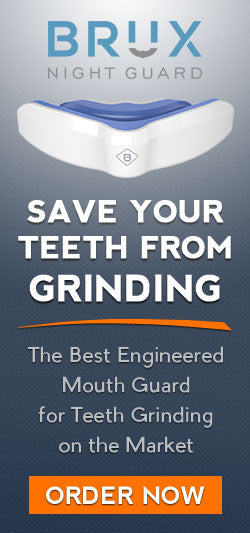7 TMJ Exercises to Relieve Jaw Pain
We don't generally think about all the work our jaw performs until it starts causing pain. The temporomandibular joint actually does a lot of heavy lifting though, so TMJ exercises can help reduce some of the stress that causes pain in the jaw.
The TMJ joints connect the jawbone to the skull and they're putting in a substantial effort every time we yawn, speak, chew, talk, laugh, and even swallow.
When it comes to jaw pain, there are a few approaches anyone can take to get some relief. In addition to regularly practicing TMJ jaw exercises, a mouth guard for TMJ that is usually worn at night while sleeping can diminish jaw pain in the morning when waking up.

Why Do People Experience Jaw Pain?
There are quite a few reasons why some people develop TMJ disorders, which can include injury to the jaw, overuse of the joint because of issues like teeth grinding or clenching, and even arthritis in the TMJ joint that can lead to inflammation and pain.
The symptoms of TMJ disorders can range from mild and annoying to others that are more severe. With the most severe symptoms, chronic jaw pain from TMJ can seriously diminish a person's quality of life.
Some of the Most Common TMJ Symptoms Can Include the Following:
- Headaches
- Ear, face, neck, and jaw pain
- Lockjaw (Trismus)
- Difficulty chewing due to pain
- Popping or clicking sounds in the jaw and ears
How Do Jaw Exercises For TMJ Help Relieve Pain?
Like with other joints in the body, TMJ exercises can be beneficial for improving movement in the jaw.
Jaw exercises help relieve pain by strengthening the jaw, stretching the soft connective tissue to increase mobility, and reduce the annoying clicking and popping sounds.
Healthy and strong temporomandibular joints are less likely to cause unexpected problems and pain, especially in the morning if grinding and teeth clenching at night is an issue while sleeping.
Many people even unknowingly grind or clench their teeth during the day when stressed out from work or other obligations.
Here are 7 TMJ Exercises for Jaw Pain
- Relaxation and Stress Reduction
In a seated position, relax the jaw and slowly inhale air through the nose and into the stomach instead of the chest.
Next, slowly exhale air out of the mouth, while focusing on a loose and relaxed jaw.
Repeat the Relaxation and Stress Reduction process several times. Make a point of performing this exercise at least a few times throughout the day when you're experiencing jaw pain.
- Open Mouth Stretch
With your head in a neutral position, open your mouth as wide as comfortably possible.
Hold the stretch, with the tongue in a relaxed position, for 5 to 10 seconds, and then slowly close the mouth without clenching the jaw.
Do the Open Mouth Stretch up to 10 times in a row.
- Push Jaw Stretch
With the tongue touching the top of the mouth, push your jaw forward as much as it will go.
Hold this position for up to 10 seconds and then retract the jaw as far as it will go, keeping this position for the same amount of time.
Repeat the Push Jaw Stretch movement several times.
- Gliding Jaw Stretch
With the head in a neutral position, slowly and deliberately glide the jaw side to side.
As it becomes more comfortable, hold the jaw on either side for 5 to 10 seconds.
Perform the Gliding Jaw Stretch exercise a few times to relieve tension and pain.
- Closing Resistance Exercise
Using the index fingers on both hands, squeeze the chin while you slowly open and close your mouth.
You will feel the resistance in your jaw with each movement. The Closing Resistance Exercise helps to strengthen muscles in the jaw.
- Open Resistance Exercise
With your thumb firmly placed beneath the chin, open the mouth slowly while pushing against the chin for resistance.
Hold this position for up to 5 seconds and repeat the movement several times.
The Open Resistance Exercise also helps strengthen the jaw muscles.
- Assisted Jaw Stretch
With a finger placed on the TMJ joint and the index finger of the other hand placed on the chin, slowly open mouth as much as is comfortable and apply pressure to the chin for the stretch.
Hold the position for several seconds and repeat the Assisted Jaw Stretch up to five times.
Videos That Demonstrate TMJ Exercises for Jaw Pain
The TMJ exercises above can be effective for reducing jaw pain in the temporomandibular joint, and can be done when discomfort appears as a way to relax or strengthen the jaw.
For those who would benefit from a visual demonstration, this video by Ask Doctor Jo illustrates simple stretches and exercises to relieve jaw pain.
Adam Fields DC also has a series of videos that demonstrate useful TMJ exercises for pain. https://www.youtube.com/watch?v=EM18snVgV_c
Alternatives to TMJ Exercises For Jaw Pain
TMJ Exercises for jaw pain can be effective for most people when done regularly, even when it isn’t hurting. But there are other ways to alleviate pain caused by TMJ.
- Ice Pack or Cold Compress
Using an ice pack or cold compress on a sore jaw can reduce swelling and inflammation that causes pain. Place an ice pack on the jaw for 10 minutes, several times a day when pain flares up. This helps to promote blood flow to the area. A weighted heating pad that also functions as a cold pack works great.
- Over the Counter Pain Medications
Over the counter pain medications like ibuprofen (Advil or Motrin) or Aleve will reduce pain and possibly even inflammation caused by TMJ jaw pain. These don’t require a prescription and can be found in all grocery stores or pharmacies.
- Stress Reduction Techniques
There are many stress reduction techniques that can be used to calm the body and mind to alleviate clenching and grinding that lead to TMJ jaw pain. Practicing yoga, meditation, mindfulness, and mindful breathing all promote a sense of calm.
Taking a warm shower or bath before going to bed each night relaxes the body and mind for more restful sleep. It also decreases the amount or severity of grinding and clenching while sleeping.
- Botox For TMJ
Botox for TMJ is a treatment method that has shown to be effective for reducing pain by relaxing the muscles in the jaw that cause tension and headaches. The jaw is still able to functional normally, but unconscious movements are reduced in the areas where Botox is injected.
- EPAT Shockwave Therapy
EPAT Therapy, also known as Extracorporeal Shock Wave Therapy (ESWT), uses impulse pressure waves to treat pain and speed up the healing process. It is used for a number of health conditions, including TMJ.
- Stop Chewing Gum
This might be a no-brainer, but it still needs to be said that chewing gum regularly could be causing TMJ jaw pain, or at least aggravating it.
It’s quite easy to stop chewing gum and switch to breath mints for those who are concerned with having fresh breath. After a week or so, the pain should subside if chewing gum was causing a problem with jaw pain.
In addition to not chewing gum, it’s also advised to stop eating or chewing hard foods such as carrots that can cause extra stress on the jaw.
Hopefully the TMJ exercises listed above will help provide some relief from aggravating jaw pain, and the accompanying alternatives to the exercises will offer even more relief.



